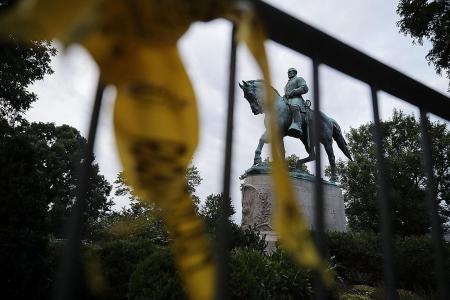Contentious statues can be teaching tools
They should be accompanied by explanation and even 'opposing monuments' because to destroy them is to lose part of history
Statues live. The Robert E. Lee statue in Charlottesville certainly does.
The majority of Americans, including his fellow Republicans, disapprove of US President Donald Trump's defence of Confederate monuments and his tardiness in condemning the white supremacists whose protests against a decision to remove the Lee statue led to the violence that killed a woman demonstrating against them.
White House aides leaked their anguish to the press. Republican politicians explicitly criticised Mr Trump's stance, military leaders did so implicitly and Mr Trump disbanded two presidential advisory councils after several chief executive officers quit the groups in protest over his Charlottesville remarks.
Mayors in several cities said they were preparing to remove Confederate statues.
In Durham, North Carolina, protesters lassoed a century-old statue of a Confederate soldier and pulled it off its plinth; several people were later arrested.
Mayor Catherine Pugh of Baltimore ordered the removal of Confederate monuments in the middle of the night, arguing that "it was in the best interests of my city."
On Friday, Maryland authorities removed the statue of a 19th-century chief justice who wrote a decision in favour of slavery.
Momentous as the fallout from the Charlottesville rally and battle has been, it is part of a global trend.
Though set in marble or bronze, meant to last and impress through the ages, statues everywhere now show themselves to be porous, forced open to controversy, challenge and the bitterness of collective memory.
Germany was purged of its Nazi iconography (much had been destroyed by the war's end by the Allied occupiers, who issued an order in May 1946 that "every existing monument, memorial, poster, statue, edifice, street or highway name marker, emblem, tablet or insignia" must be destroyed).
ON SALE: FASCIST MEMORABILIA
Italy was not. Fascist architecture and monuments, including paintings, frescoes and mosaics glorifying fascism, usually by associating it with classical Rome, remain.
In Benito Mussolini's birthplace, the small town of Predappio, shops line the main street selling fascist memorabilia and pamphlets. An ornate underground tomb holds the dictator's remains and a bust stands in a villa where he lived and pro-fascists parade up and down the streets, venerating the tomb.
The town's mayor has raised funds to build a museum spelling out the truths, as against the myths, of fascism in an attempt to rescue the town's civility.
Other villains still have their places of honour. Statues of Russia's Joseph Stalin are displayed in a museum in his Georgian birthplace of Gori and elsewhere.
In China, a solid gold statue worth some 200 million yuan (S$41 million) stands in Chairman Mao's birthplace of Shaoshan, with hundreds of other less expensive monuments all over China.
The argument for tearing down statues of those now regarded as leaders of imperialist expansion and/or racists is straightforward: They continue to act as reference points for those who view them not with aversion but with admiration.
Those who honour them identify themselves with the figures they regard as heroes of history, and gain strength and confidence through the identification.
The competing argument is that to destroy these monuments is to lose part of an understanding of history itself.
Yet merely standing as they have for decades, or centuries, is not now enough.
Instead, they should be attended by explanation, debate and opposing views, even "opposing monuments". Stalin, for example, could be confronted by a statue of the great dissident Alexander Solzhenitsyn, or the figure of an emaciated survivor of the Gulag (forced labour camps).
Another option: harnessing technology. Film-maker David Peter Fox came up with the idea of using mobile phones as a teaching device after taking his children to see a statue of Danish writer Hans Christian Andersen in Copenhagen.
The app is activated when in the proximity of the statue to play a recording explaining the background of the memorial.
The idea is now spreading to Berlin, London, Helsinki, Chicago and New York.
A phone app will not quell the fallout from Charlottesville. It is a pointer, as well as a compromise.
If extended and expanded, it could allow an understanding of why controversial figures were once regarded highly and give space to the reasons why they are not so seen by many now.
It is sure to be scorned by activists. But it speaks to reason and may help to avoid what presently threatens to be an escalation of hate. - REUTERS
John Lloyd co-founded the Reuters Institute for the Study of Journalism at the University of Oxford, where he is senior research fellow.
Get The New Paper on your phone with the free TNP app. Download from the Apple App Store or Google Play Store now



